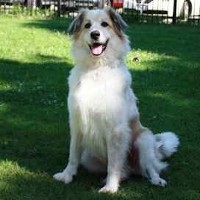Appearance of the Border Collie Pyrenees
|
| The Border Collie Pyrenees hybrid is a cross between the Border Collie and the Chien de montagne des Pyrénées, and is a large dog weighing over 29.5 kilos that may have attributes of one or both of its parent breeds. The hybrid will have a strong, robust, well-proportioned body with a coat that can be long and coarse or shorter and smoother, with a dense undercoat that protects them from colder temperatures, making them resistant to the elements. Coat color can range from white/gray/cream to black and tricolored red. Eyes can be oval or almond-shaped and rich in brown or blue, ears of medium size and carried erect or semi-erect or carried close to the head. Facial expression could be elegant, intelligent and contemplative, or intelligent, alert, eager and full of interest. The tail could be full and carried low or over the back. Skull width and length are about equal, and the muzzle is strong, with well-fitting lips and a scissor bite. The feet are rounded, well cupped and well padded, with well arched toes. |
Temperament of the Border Collie Pyrenees
|
| Border Collies can adopt the temperament of one or both of their parent breeds, the Border Collie and the Chien de montagne des Pyrénées. They can be alert, energetic, intelligent, loyal, protective, reactive, affectionate, gentle, independent and calm. Both parent breeds are excellent with children and other animals, and get along quite well with strangers. Both parent breeds are intelligent, but the parent Pyrenean Mountain Dog contributes independence to the mix, making training difficult. Both breeds are quite energetic, with the Border Collie parent bringing higher energy levels to the biological mix. The Pyrenean Mountain Dog parent contributes higher degrees of wanderlust, barking and howling, and prey drive to the biological mix. Neither parent breed tolerates warm weather well, but both are well adapted to cold tolerance. Neither parent does well when left alone for long periods, boredom giving rise to destructive behavior. |
Needs and activities of the Border Collie Pyrenees
|
| Your Border Collie Pyrenees can be very active and energetic. The Border Collie parent brings high energy to the gene pool, while the Pyrenees Mountain Dog parent is a little calmer. That said, your hybrid's energy levels will depend on which breed parent has the greatest influence in the biological gene pool. The higher the energy level, the more active your pet will be, and the greater the pressure on the human family to keep him exercised and challenged, both mentally and physically. Daily walks and runs, combined with plenty of fetch and Frisbee games, will help to discharge some of this natural physical energy. Both breed parents bring high levels of intelligence to the hybrid mix, so it's up to the human owner to keep it mentally challenged to avoid some of the destructive behaviors that accompany boredom. Because energy levels are quite high in this hybrid, it's not recommended that this large dog be subjected to apartment living. He'll do much better in a family home with a fenced-in yard where he can run, romp and play. He can live in both urban and rural areas as long as appropriate exercise options are provided or readily available. Both breed parents were developed for colder elevations and, as such, have difficulty tolerating warmer climates. They will, however, do well in more moderate temperatures, as opposed to subtropical or tropical regions. |
Maintenance of the Border Collie Pyrenees
|
| The Border Collie Pyrenees hybrid, like its pedigree parents, requires a moderate amount of grooming maintenance, with higher levels of maintenance required during normal periods of seasonal shedding. Brushing at least twice a week will help to better control shedding, with an additional once or twice a week recommended during these periods of seasonal shedding. Thorough brushing, paying attention to the dense undercoat as well as the softer outer layer, is the recommended brushing technique to keep the long, dense layer free of mats and debris. Frequent brushing will not only reduce the amount of hair that needs to be vacuumed, but also keep the coat cleaner. Bathe and wash your pet dog only when necessary to preserve the oil in the coat, which keeps it weather- and water-resistant. This hybrid is no different from most other canine breeds in that regular, careful attention to teeth and ears is recommended for ear cleanliness and reduced potential for infection, and for teeth to prevent or reduce periodontal disease that can lead to tooth loss. |









 English (United Kingdom)
English (United Kingdom)